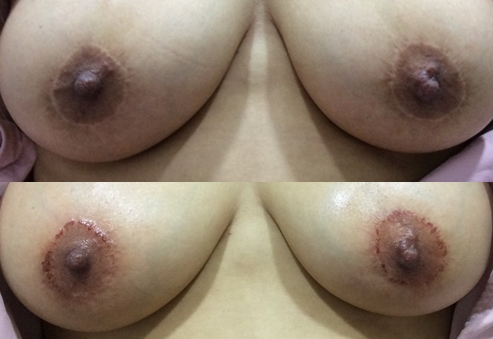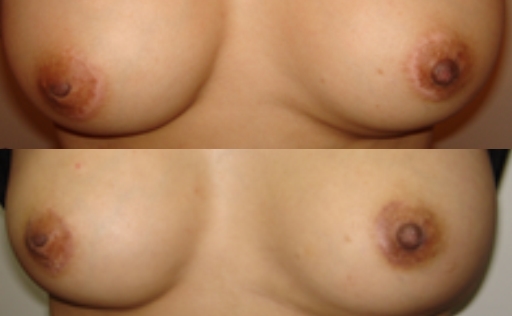
It is imperative that the tattoo technician first accurately communicate to the patient the type of his or her scar before starting the treatment. In the case of linear hypopigmented lesions where favorable outcome is relatively easy to achieve, trying to fill the entire scar with the same color as the surrounding skin may result in creating another noticeable linear scar. In such a case, the goal should be filling parts of the linear depigmentation with ink so that the noticeable single linear lesion becomes several shorter, less noticeable lesions.
The patient may be more satisfied with this result (Image 1, 2). Even if the outcome is not perfect, if improvement is seen, most patients are satisfied with the first treatment. Extensive explanation is a must if the patient has a hypertrophic scar or keloid. Many of these patients have been told their skin type is a contraindication to tattooing and tend to be skeptical of the benefits of reconstructive tattoo treatments.

Image 1. Scar from areolar reduction (top) and immediately after touch-up at 1 month of reconstructive tattooing (bottom).

Image 2. Breast augmentation scar (top) and a month after reconstructive tattoo (bottom).
I always carry out pre-treatment testing (Image3). As shown in Images 3 and 4, testing is carried out in the size of a thumbnail in the target site. I generally use a slightly lighter color than the surrounding skin. The test result is assessed 2 weeks later and a full treatment is determined. This allows me to ease the patient into the first treatment and also build trust for them to come back for subsequent treatments. As a predictable outcome is clearly communicated, the tattoo technician and patient can be on the same page. There is no charge to the patient for testing.

Image 3. Before (left) and 2 weeks after (middle) spot testing. During treatment (right).
After communicating to the patient about the type of their scar, it is also important to discuss the treatment outcome. Similar to other aesthetic treatments, the outcome of a tattoo procedure differs from immediately after treatment to a month or 6 months after. I have discussed this at length in previous articles regarding how ink particles behave in the human body. You can look a year or 2 years ahead for a more long-term outcome, however, patients may not be willing to wait for that long for the final outcome. Therefore, it is better to focus on the short-term outcome.
[Advertisement] MAGNUM(Q-switched Nd:YAG Laser) – Manufacturer: (www.i-dana.com)]
Image 1 shows tattoo treatments performed a month apart for removal of linear scars after areolar reduction. The outcome of the first treatment was explained in pre-treatment consultation and retouching was done a month after. A lot of women and men are sensitive about the appearance of their nipples. If surgical areolar reduction resulted in noticeable scars seen in Image 1, it may be a cause of distress for the patient. In this case, additional scar removal would not be a good choice. Surgery will not be effective in widening scars with hypopigmentation. It would be even more devastating for both the patient and doctor if secondary scar removal surgery failed to bring any improvement. Therefore, I believe surgery is not the right option in such cases. As mentioned earlier, inserting pigment to separate segments of the linear lesion would make the scar less visible and may be the best removal method.




















